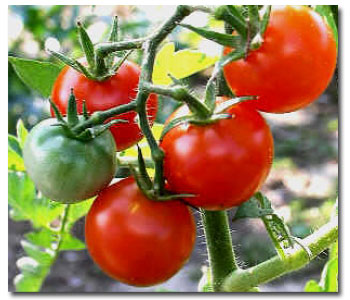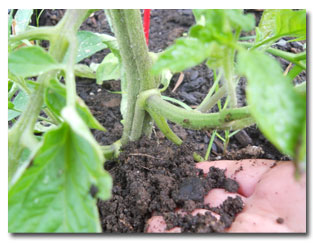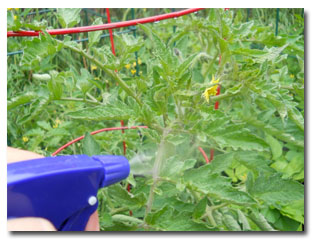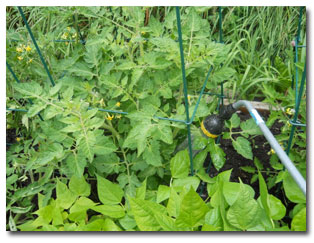Boost Vegetable Production with these 4 steps!

Your are the guardian of your own tomatoes!
You might think there is very little to do in the garden this time of year- just weed, water and repeat. However, you are the guardian of your tomatoes and therefore responsible for ensuring their well-being AND I know you want to increase the chances of a bumper crop! Since you want them to be healthy and since you want the biggest yield of the best tomatoes you can grow, you will want to give them some care and attention mid-season, to give them a boost towards the end goal: ripe tomatoes goodness.
There are a few mid-season tasks for vegetable gardeners. In brief, I recommend adding a layer of mulch, amending the soil, applying a foliar spray, and watering efficiently.

1. Mulch your Plants: We are only moving into warmer weather as the season wears on. While it’s true that tomatoes do thrive in fairly warm temperatures, they can get dehydrated too quickly if the soil is left exposed. Put down a layer of mulch, commonly in the form of straw or compost, to keep the moisture locked in and to bring soil temperature down a few degrees. This also serves to keep any fertilizer moist and adds organic matter back in, over time.

2. Amend the Soil: adding a good soil amendment to your tomato bed mid-season serves two important roles: it feeds your plants and it boosts your soil. Both are key to the health of your tomatoes. By adding organic soil amendments, such as good quality compost or John and Bob’s microbe-rich products, you are adding not only nutrients to the soil but microbes and food for microbes which help to sustain your plants over time. Conventional fertilizers add a boost of nutrition but it’s not sustainable and ultimately, it depletes the soil and adds too much salt. To amend the soil mid-season, add a few handfuls high-quality compost or other soil amendment to the top of the soil around the base of your plants.

3. Apply Foliar Spray: I recommend applying seaweed extract and compost tea every other week to prolong the season and stave off disease. You can make this yourself (see my tutorial on compost tea) or buy some. The liquid can be sprinkled at the base of plants but it can also be sprayed on the foliage. The microbes and other ingredients in the spray help to strengthen the cell walls of the plant as well as keep fungal diseases at bay. The high microbe content in compost tea works to crowd out any pathogens, extending the season for your fruit. John and Bob’s Penetrate also contains the right beneficial microbes to protect plants and can be used in place of compost tea.

4. Water Efficiently: Tomatoes need a moderate amount of water. An infrequent, thorough, deep watering is the best. When a seedling is just planted, I water deeply once a week. Then, as the season progresses, I look at the plant in the cool morning air and see if the foliage is droopy or limp at that time. If it is, then that is when I apply another deep watering. Do not look at the plant in the mid afternoon heat and determine its droopy foliage as a sign that the plant needs water. Droopy foliage is normal on hot days and is just the plant’s way of protecting itself.
If you have more questions or ideas about mid-season tomato care, drop me a line! You can find me on Facebook or contact me on my website! I always love to hear from you.
Article Coutesy of Steve Goto, Gotomato











